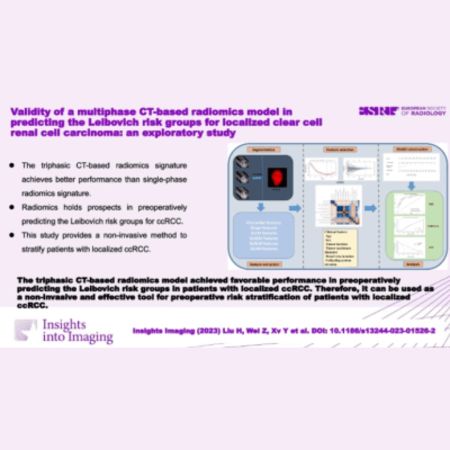Renal cell carcinoma (RCC) is the most common kidney malignancy, with clear cell renal cell carcinoma (ccRCC) being the most predominant subtype. Despite surgery being the main treatment, a significant portion of patients experience recurrence or metastasis, especially those with advanced disease. The Leibovich scoring system assists in predicting disease progression post-surgery but is only available after pathology assessment. Currently, there's a lack of non-invasive methods to stratify patients preoperatively. A recent study published in Insights into Imaging retrospectively enrolled 425 patients with primary localised ccRCC from two medical centres to develop and validate a multiphase CT-based radiomics model for preoperative risk stratification. This model aims to predict Leibovich score risk groups, aiding in patient management and treatment decision-making.
Retrospective Data Collection and Patient Selection Criteria
Computed tomography (CT) is essential for evaluating localised ccRCC but insufficient for predicting post-surgery progression risk. Radiomics, which characterises tumour heterogeneity and aggressiveness through mathematical features extracted from medical images, has shown promise in various cancers but has been minimally explored in ccRCC prognosis. The study authors obtained data retrospectively from two clinical centres: the First Hospital of Chongqing Medical University (centre 1) and the Second Hospital of Chongqing Medical University (centre 2). The study included patients who underwent nephrectomy with confirmed ccRCC pathology and had undergone preoperative plain and three-phase enhanced CT scans. Exclusion criteria included prior treatment, incomplete or poor-quality CT images, recurrent/metastatic/bilateral ccRCC, other malignancies, or incomplete clinicopathological data. A total of 425 patients were enrolled, with 381 from centre 1 divided randomly into training and validation cohorts (7:3 ratio), and 44 patients from centre 2 forming an independent external testing cohort. All pathological diagnoses were validated by an experienced pathologist.
Development of a Novel Triphasic CT-Based Radiomics Model for Predicting ccRCC Progression Risk
The study aimed to develop and validate a novel triphasic CT-based radiomics model to predict Leibovich risk groups before surgery in patients with localized clear cell renal cell carcinoma (ccRCC). Leveraging radiomics, which extracts numerous features from medical images, the researchers sought to address the need for non-invasive tools in predicting ccRCC progression. Previous studies indicated the potential of radiomics in RCC, particularly in differentiating benign and malignant tumours and classifying subtypes. The researchers extracted radiomics features from both monophasic and triphasic CT images of 425 ccRCC patients. Utilising a LASSO regression algorithm, they filtered 13 features to construct radiomics signatures for predicting Leibovich risk groups. Notably, the triphasic radiomics signature outperformed single-phase approaches, demonstrating higher predictive performance and better characterization of tumour heterogeneity and aggressiveness.
Key Features and Clinical Integration of the New Prediction Model
Key radiomics features included shape features, first-order features, and higher-order texture features, with the original_shape_Maximum2DDiameterColumn feature being prominent. The incorporation of significant clinical factors such as renal vein invasion and Rad-score further enhanced predictive accuracy. Decision curve analysis (DCA) confirmed the clinical utility of the radiomics model, showing higher net benefits compared to alternative strategies. However, the study acknowledged limitations, including a limited sample size and manual segmentation biases. Future research directions were proposed, emphasising the need for prospective studies with larger samples and the integration of multi-omics data to improve predictive models. The study's methodology adhered to standard radiomics processes, aiming for better generalizability, reproducibility, and clinical utility. The developed dynamic nomogram provided an interactive visualisation of the statistical models, enhancing clinical applicability. Despite its strengths, the study recognised the need for further validation through prospective multicentre studies.
In conclusion, the study presented a robust triphasic CT-based radiomics model for preoperative risk stratification in localized ccRCC patients. This non-invasive tool offers promise in aiding clinical decision-making and disease monitoring. However, ongoing research efforts are necessary to address limitations and validate the model's performance in larger and more diverse cohorts.
Source & Image Credit: Insights in Imaging
























